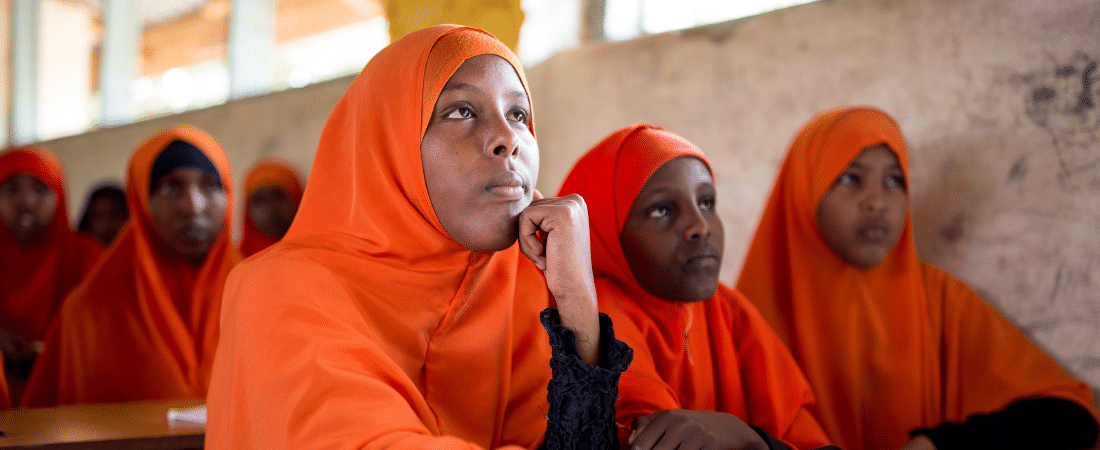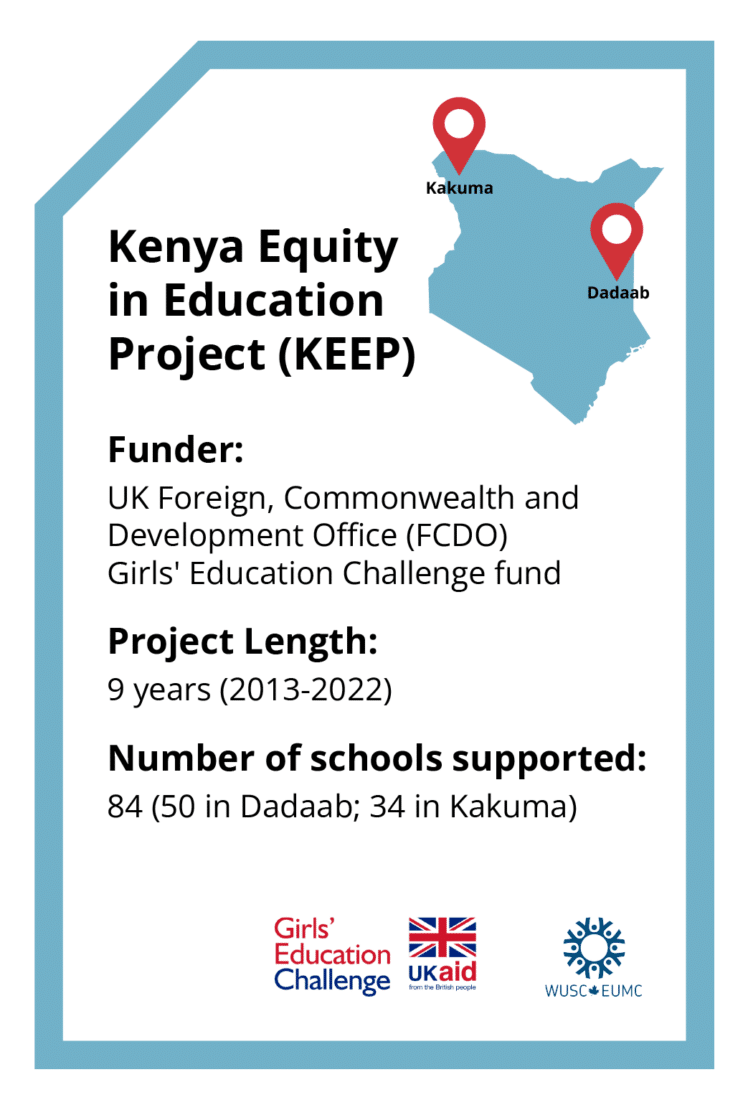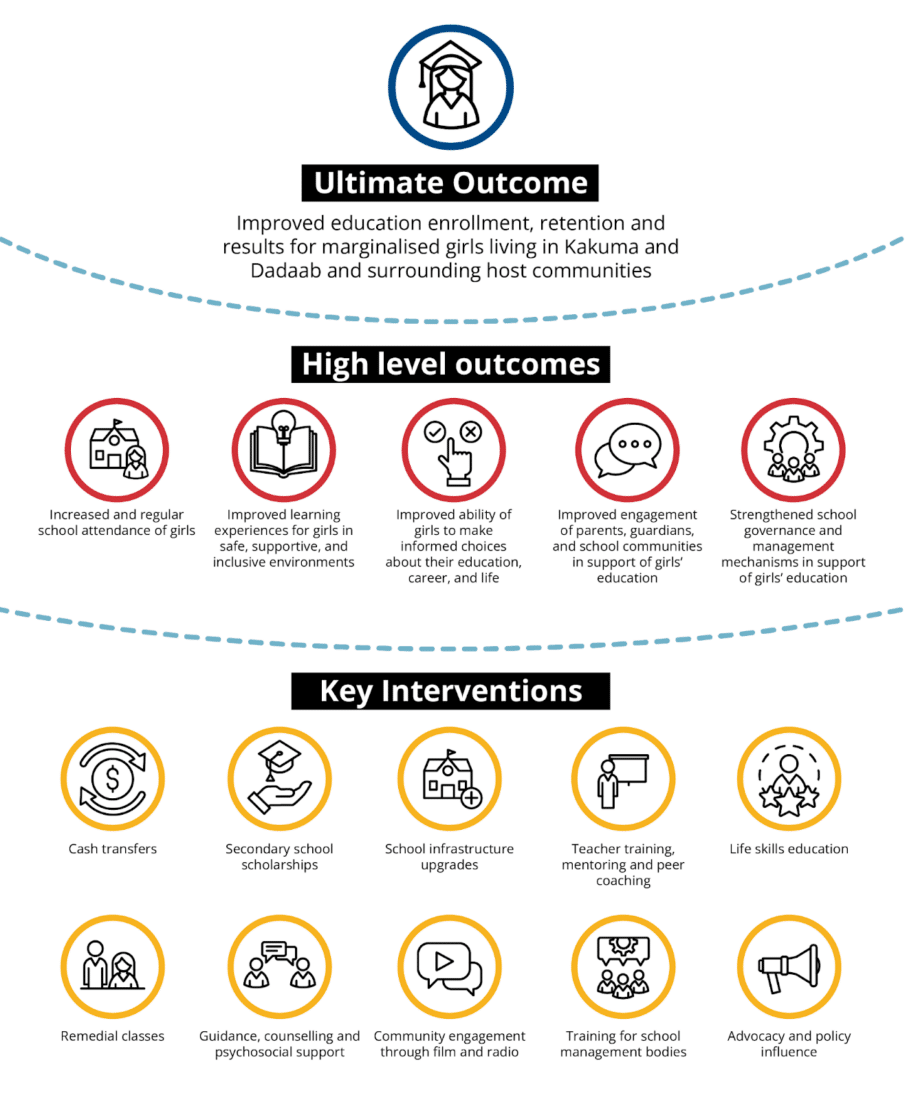
Reflecting on a Decade of Girls’ Education Programming in Kenya
What we have learned from our work to improve girls’ education in Kakuma and Dadaab Refugee Camps and the surrounding host communities in Turkana, Garissa and Wajir counties in Kenya
It has been a decade since WUSC and its partners launched the Kenya Equity in Education Project (KEEP). In that time, we have developed key partnerships to support girls and their communities in 84 schools across Kenya to deliver a range of interventions and worked in close collaboration with national education officials to contribute to the improvement of girls’ education. As this project draws to a close, we have a lot to celebrate and many learnings to share. This blog will spotlight key results and successes of the project and highlight important lessons learned.

Girls living in Kakuma and Dadaab refugee camps and the surrounding host communities in Turkana, Garissa, and Wajir counties of Kenya face a multitude of challenges affecting their ability to access education.
Deeply ingrained social norms and gender stereotypes limit the perceived value of a girl’s education, instead emphasizing domestic work and even early marriage. In addition, low self-esteem and harmful traditional practices affect girls’ ambitions and their sense of agency to make decisions about their lives and their futures.
For those who do enroll, under-resourced schools, overcrowded classrooms, and teachers with limited training or support means that the quality of education has historically been low.
The context we operated—Turkana, Wajir, and Garissa counties—regularly register the lowest gross enrollment rates, the highest pupil to teacher ratio, and the lowest academic performance in the country.
Furthermore, limited expertise and resources mean that schools and teachers do not always know how best to support and cater for learners’ social and emotional needs and development.
Because of these challenges, many girls in these communities are not attending school or are being forced to drop out before completing their primary or secondary studies.
Launched in 2013 with funding from the UK’s Foreign, Commonwealth and Development Office (FCDO) as part of their Girls Education Challenge (GEC), KEEP was designed to address the multiple barriers girls face when accessing education, staying in school, and successfully completing their academic studies. Through a multipronged approach, KEEP has supported girls, school systems, and communities through an array of interventions.
DRIVERS OF SUCCESS
Here is an overview of key interventions to improve education enrollment, retention, and quality.

KEY SUCCESSES & RESULTS
Attendance: Attendance rates among girls increased throughout the course of the project. Cash transfers had a positive effect on attendance, retention, and transition from primary to secondary school. Girls receiving cash transfers maintained over 90% attendance levels throughout the project, even after the COVID-19-related school closures.
“Implementation of cash transfers continued even when schools reopened, and this really helped the girls get back to school. I can say that some of them only came back to school to get that money because otherwise, they would miss it.” Guidance and counseling teacher, Dagahaley
Community stakeholders also shared that KEEP scholarships were an important motivator to keep girls in school and encourage them to perform well.
Teaching and learning quality: Since the start of the project, there has been an increase in the number of girls qualifying to sit for national exams every year in Kakuma, Dadaab, and the surrounding host communities. In addition, girls are now among the top performers of national primary and secondary school leaving exams, which was not the case before KEEP.
However, girls’ perceptions on improvements in teaching quality are mixed and varied by region. In Garissa, the proportion of girls who agreed that their teachers made them feel welcome and that girls received the support they needed to perform well in school increased, but decreased for Turkana. And while there is evidence of knowledge shared between trained and untrained teachers, this varied significantly by school.
“We used to benefit from the teachers who went for the training. Personally, when I was finding it difficult to handle the large classrooms, I was helped by one of the teachers who went for the training, and I am now able to handle my class with no difficulty.” Teacher from Kakuma Refugee Secondary School
Life skills and self-efficacy: There have been significant gains in self-esteem, confidence, and decision-making, all of which are critical life skills that support girls’ sense of agency and decision-making. A study conducted in the final year of the project showed a 6% increase (48% to 54%) in self-confidence among girls and included evidence that life skills education can be a powerful tool for academic engagement and motivation, both of which are essential precursors for academic performance and success. All girls reported that they made new friends and increased their social support networks. Girls also shared that they felt more empowered to make decisions, including when and if they get married.
KEEP emphasized the need for guidance and counselling in schools. At endline, guidance and counselling units are functional in all KEEP schools and are credited with contributing to a more supportive environment for girl learners, particularly where guidance teachers and teachers are women. Stakeholders had mixed reactions about the potential of shifting life skills through peer mentors at the school level.
Community attitudes and perceptions: The vast majority of community stakeholders interviewed reported a positive shift in attitudes towards girls’ education and improved awareness of education barriers facing girls. The proportion of girls surveyed who report they get the support they need from their family to stay in school and perform well remained high. The project’s community engagement efforts through radio, film, and direct dialogue sessions on the importance of educating girls helped lead a shift in community attitudes towards girls’ education and overall empowerment.
School governance and management: KEEP focused on strengthening the capacity of Boards of Management and Parent Associations by increasing knowledge and skills in project management, resource mobilization, and conducting gender analyses. Over the course of the project, 59% of school management and governance indicated increased knowledge of gender issues and child protection and 73% of Boards of Management and Parent Associations put in place some awareness or outreach programs to increase girls’ attendance, retention, and transition in their respective school communities.
KEY LEARNINGS
Throughout the course of implementing KEEP, we have gained a deeper understanding of what works (and what doesn’t work) when it comes to supporting girls’ education. Reflecting back a decade later, our learnings from KEEP both re-affirm the effectiveness of the approaches we use and how we deliver our projects and present us with new learnings that enable us to continue to improve our work. Our most significant reflections and lessons learned for designing and implementing girls’ education programming include:
1. A nuanced understanding of the operating context is key: Our experiences with KEEP confirmed our belief that a one-size-fits-all approach is not sufficient to meet the unique and ever changing needs in dynamic and diverse operating contexts. Not only do refugee-hosting contexts change rapidly, but in the context of KEEP, the two project locations: Kakuma (primarily hosting south Sudanese nationals) and Dadaab (primarily hosting Somali nationals) have stark differences in terms of culture, prevailing norms and attitudes, and operational restrictions. This, along with unpredictable influxes of new arrivals, camp closures, and the effects of the Covid-19 pandemic, means that our understanding of a context not only needs to be nuanced but also fluid and evolving. Adapting program design and implementation to suit these unique needs and remaining flexible to continuous adaptations is critical to a program’s success.
2. Collaboration with key ecosystem actors is critical for success and sustainability: This key lesson also reaffirmed the effectiveness of our approach of partnering with diverse stakeholders in delivering our programming. The relevance and sustainability of education interventions are improved when their design is aligned with national education system delivery and when they are developed in collaboration with national and local education ecosystem actors. Having a strong understanding of existing systems, structures, actors and dynamics within the operating space enables programming to identify and utilize critical entry points and focus on complementarity, value-addition and sustainability, rather than duplicating efforts and operating in silos. Building on learnings from the first phase of KEEP, we shifted our approach from directly delivering teacher training and guidance and counseling in schools to working in collaboration with the Ministry of Education and Teacher Service Commission. As a result, KEEP has influenced the strengthening of the national Guidance and Counseling policy, as well as the capacity of education officials who provide professional development support for teachers.
3. Empowerment needs to be central for programming to be truly transformative: Putting girls’ own individual choice and agency at the center of programming is not only more empowering, but more effective and sustainable. Rather than assuming what is best for girls, empowering girls with the tools to make decisions and act upon their own choices removes any predetermined notion of success and makes girls’ priorities our priorities. This is something we have built into subsequent girls’ education programming to ensure girls have the power to choose what education and employment pathway makes the most sense for them. It is critical that this is complemented with coordinated community engagement to generate active and meaningful family and community support that supports and enables female empowerment.
4. Effective guidance and counseling support can improve girls’ participation and performance in school: In fragile environments, safety and psychosocial wellbeing are even more critical as challenges are magnified and vulnerabilities heightened. Investing in multilayered approaches to build and strengthen protective measures for learners, especially girls, are needed to ensure schools and communities are safe and supportive for all young people. Strengthening in-school support for psychosocial care through the establishment of functional guidance and counseling units and equipping school staff with the knowledge and skills to support social and emotional learning, as well as strengthening the referral pathways to increase access to specialized support services contributes to improvements in retention, participation, and performance in school.
5. Behavior change requires sustained investment and interventions that go beyond awareness raising: KEEP’s community engagement work relied on broad-based messaging focused on awareness raising, which created some shifts in knowledge and attitudes but evidence of this being translated into action was limited. We’ve learned that interventions designed to drive behavior change need to be approached differently, especially when it comes to community engagement. We have built upon this in other programming in Kakuma, whereby we are implementing a much more comprehensive approach that takes community members through a phased approach that moves beyond information sharing and focuses on a community-wide process of personal reflection and collective action. In Uganda, we have also introduced flexible response funds to support communities to design, fund and action innovations and solutions that support girls’ education.
The successes of KEEP would not have been possible without the support of FCDO and our programming partners, including Africa’s Voices Foundation, FilmAid, CGA Technologies, and White Ribbon, as well as the ongoing work and dedication of teachers, education leaders, and community advocates in Kakuma, Dadaab, Turkana, and Garissa.
To read more about the approaches, interventions, impact and learnings from KEEP, take a look at our KEEP Project Reflection on the Girls’ Education Challenge (GEC) site, along with learning summaries from other GEC projects from around the globe.
To find out more about WUSC’s work to support girls’ education, take a look at our current work in Kenya, Uganda, South Sudan and Mali, all of which build upon the successes and learnings from KEEP.
To support this work learn more about HerFuture campaign and donate.
WUSC works to create a better world for all young people. To learn more, start here or subscribe to get highlights straight to your inbox. Interested in volunteering internationally? View our current opportunities. Looking for a new career opportunity? Check out our current job openings. Or show your support for our cause by making a donation.
